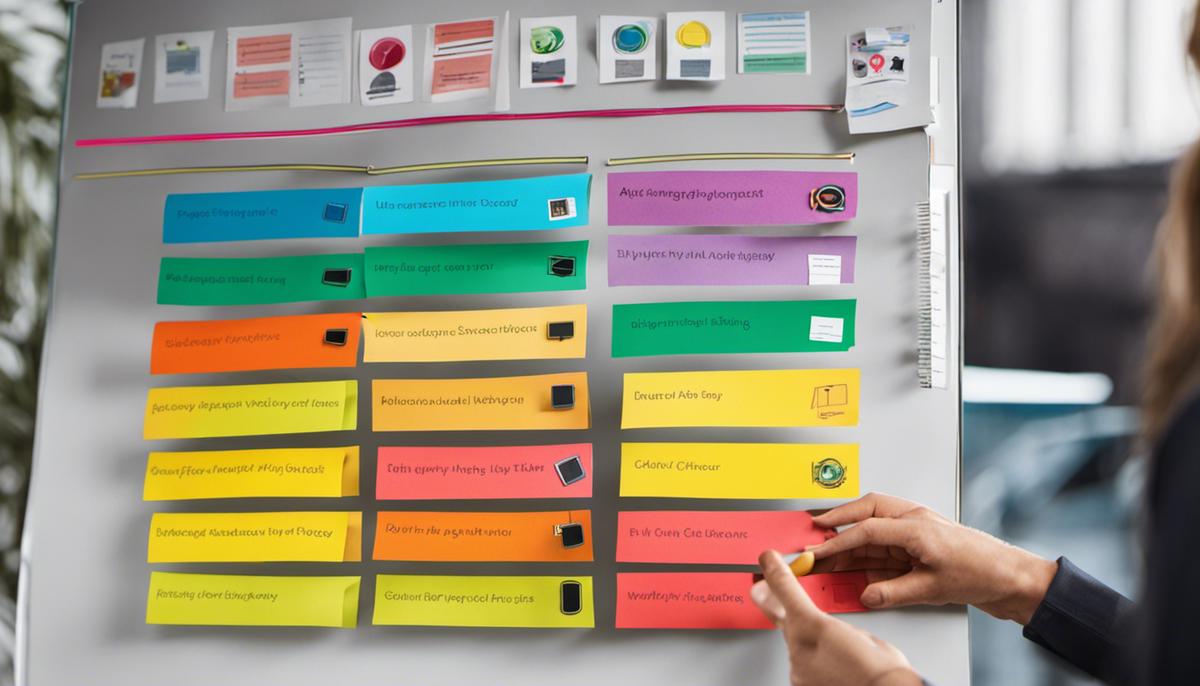These demanding times require us all to perform a balancing act, juggling the demands of our professional lives with the basic human need for rest, relaxation, and personal growth. The quest for work-life balance is not only a personal pursuit but a key factor in maintaining mental health and job satisfaction. To achieve this state of equilibrium, three significant aspects need to be addressed: Prioritization of tasks, boundary setting, and mindfulness combined with self-care. So, let’s delve into understanding how mastering these elements can lead to a well-adjusted lifestyle with a harmony between your work and personal spheres.
Prioritizing Tasks
Unleashing the True Potential of Prioritization for Achieving Work-Life Balance
There’s a popular saying in the world of entrepreneurship which says, “Time is money.” But if you delve deeper into the nuances of managing a thriving enterprise or juggling multiple roles, you soon realize that it’s not just about time. It’s about using that time most effectively. It’s all about prioritization.
Why is Prioritization Vital?
Prioritizing tasks is essentially understanding the importance of each to-do item and organizing them in order of their impact on achieving objectives or goals. It is a strategic tool, one that successful entrepreneurs, managers, and high-achieving business professionals harness to fuel productivity, reduce stress and, most importantly, create a healthy work-life balance.
The Marvels of Prioritization
The most immediate reward of prioritization is enhanced productivity. Determining the significance and impact of each task allows you to focus on what is immediately critical, thereby avoiding unnecessary distractions. This focus fosters efficiency, boosting productivity.
Moreover, effective prioritization has a direct link to stress reduction – a vital aspect contributing to striking that elusive work-life balance. Juggling several assignments and responsibilities can overwhelm even the most resilient of us. Prioritization allows for a methodical approach, thereby eliminating the chaotic, anxious feelings that adversely affect performance and cloud decision-making abilities.
Achieving Work-Life Balance through Prioritization
Work-life balance isn’t just a buzzword tossed around in professional circles. It’s the key to unhindered productivity, increased job satisfaction, and maintaining healthy personal relationships. Prioritization serves as a compass, guiding you to not only identify which tasks contribute to your professional growth but also recognize activities that rejuvenate you personally.
Progressing in the corporate world doesn’t mean you have to comprise your personal growth or time for your loved ones. Work-life balance calls for you to identify and prioritize tasks that contribute to your holistic development.
Sidestepping the Perils of Over-prioritization
However, vigilance while prioritizing is crucial. Excessive prioritization can lead to what seasoned professionals term as “over-prioritization.” This means when you start ranking everything as high priority, ultimately leading to a distorted understanding of what’s truly important. Therefore, it’s essential to be conscious while assigning importance to the tasks.
Becoming a Champion at Prioritization
One of the most effective ways of becoming adept at prioritization is to regularly reassess your tasks as your priorities change with time. Employ various tools available like priority matrixes, the Eisenhower Box, or even simple to-do lists, replete with deadlines for each task. Seek mentorship and learn from those successful at balancing their professional and personal lives.
In conclusion, the potential of prioritization is multifaceted and vast, but often underestimated. Unlocking this potential can lead to a rational approach towards tackling tasks, reduced stress levels, and substantial strides towards a balanced and fulfilling professional and personal life. Remember, it’s not about racing against the clock; it’s about making every minute count.

Establishing Boundaries
The Critical Role of Boundaries in Fostering Work-Life Balance: How To Set Them Up
The scramble for increased productivity and efficiency in our digital-first world has brandished a new gold standard – work-life balance. It is a realization gradually penetrating the global workforce, how this elusive equilibrium fuels both professional success and personal fulfillment, outside of overemphasized prioritization concepts. At the heart of this balance, establishing boundaries reveals itself as an indispensable catalyst.
Boundaries, while often taken for granted, play an integral role in creating a resilient work-life balance architecture. The concept of setting limits within — and between — professional and personal spheres allows individuals to segregate responsibilities effectively; reducing the risk of overlap that might lead to stress, burnout, and a significantly decreased quality of life.
But how do we set up these boundaries? Here is a step-by-step approach to help you establish effective boundaries and enhance your work-life balance:
- Understand Your Needs: Beginning with personal introspection aids in mapping out what your actual needs from work and personal life are. Recognizing these needs will assist in determining where to draw your boundaries.
- Communicate Clearly: Once you are aware of your needs and limits, let your colleagues, superiors, and family know. Clear communication about your boundaries will pre-empt potential difficulties, fostering mutual respect and understanding.
- Institute Structure: Consider specific infrastructure within your day-to-day routine for your professional and personal life that helps maintain these boundaries. This structure may involve setting designated working hours or limiting accessibility during your off-hours.
- Polish Your Time Management Skills: Honing time management abilities is essential in firmly upholding boundaries. Implementing tools and techniques like Eisenhower Matrix, Time Blocking, or the Pomodoro Technique can be beneficial.
- Leverage Technology: Use technology to your advantage. Several apps and devices can automate tasks, manage distractions, handle communications, and thereby fortifying boundaries.
- Practice Saying No: Acquiring the ability to refuse additional tasks or roles that might infringe on your boundaries is pivotal. Though it might seem daunting initially, this practice plays a significant part in boundary maintenance.
- Evaluate Regularly: Constant monitoring and assessment of these boundaries are vital. Changes in professional and personal circumstances may warrant adjustments. Being open to these changes and flexible in revising the boundaries is key.
Setting boundaries might initially seem like a daunting effort hampering productivity. However, taking the plunge reveals a different perspective, where boundaries provide an arena for increased productivity and more profound personal satisfaction. In the race for growth and accomplishment, the need for boundaries in not a luxury but a necessary strategy to maintain sanity and happiness in the long haul.

Mindfulness and Self-Care
Mindfulness and self-care are integral parts of building a work-life balance. While prioritization and setting boundaries may lay the foundation, these two key factors can uplift and solidify the balance needed for an enriched personal and professional life.
In this non-stop, digitally-driven world, focused attention on present experiences and acceptance of one’s feelings and thoughts – the essence of mindfulness – can significantly reduce self-inflicted pressures. This can aid in performing tasks more efficiently, leading to greater productivity.
Mindfulness has also been linked to enhanced decision-making abilities. By maintaining a mindful approach towards work, one allows their mental faculties to be fully engaged and available, thus, making informed and balanced decisions. Simultaneously, mindfulness can encourage empathy, fostering better interpersonal relations within the professional arena, and beyond.
Meanwhile, self-care can be construed as the fuel for mental, emotional and physical functioning. Exercise, nutritious meals, and adequate rest can maintain its physical aspect, providing the vitality needed in both personal and work spheres. These factors can also enhance cognitive functions, promote emotional stability and build resilience towards stress – prime features of a sound work-life balance.
Further, self-care extends to mental and emotional health. Regular mental breaks, pursuit of hobbies, and social interactions allow for essential venting of accumulated stress. It is vital for organizations to cultivate an environment where employees’ wellbeing is valued and mental health concerns are adequately addressed, thus promoting a sync between work responsibilities and self-care.
Many digital solutions, ranging databases for guided meditations, workout routines, and dietary plans to inner workspace digital environments fostering mental rest, are readily available. Using such tools can assist in seamlessly incorporating mindfulness and self-care into daily routines.
Last but not least, it is essential to remember that creating a work-life balance is not a one-size-fits-all deal. Individual requirements vary, therefore one’s approach to mindfulness and self-care should be personalized, reflecting personal needs and restrictions.
In conclusion, integrating mindfulness and self-care into the work-life balance paradigm requires conscious commitment but offers in return increased efficacy, creativity, empathetic leadership, and improved relationships. Embrace these practices and watch personal and professional fulfillment unfold.

Mastering the art of work-life balance is about understanding the significance of priority setting, learning to draw a clear line between work and personal life, and embracing the concept of mindfulness and self-care. These key strategies not only enhance your productivity but also improve your mental, emotional, and physical well-being, resulting in a harmonious and productive life both within and outside the workplace. There is no one-size-fits-all solution as each individual’s circumstances vary, yet these steps can guide you in customizing your own approach towards achieving an effective work-life balance.
